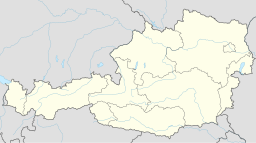Schönberg Cave System
| Schönberg-Höhlensystem | |
|---|---|
 Lapiaz (eroded calcareous rock) still partially covered by vegetation on the Sieben Hengste massif. | |
| Location | Totes Gebirge, Austria |
| Coordinates | 47°43′04″N 13°47′15″E / 47.7177604°N 13.7874445°E |
| Depth | 1,061 m (3,481 ft) |
| Length | 156.9 km (97.5 mi)[1] 155.637 m[2] |
| Height variation | 1061 m[3] |
| Discovery | AD 1966 |
| Geology | Limestone |
| Entrances | 42 |
| Website | www.hoehlenforschung.at |
The Schönberg cave system in the Dead Mountains is with a currently known length of over 155.018 m[2] the longest cave in Austria. It got its name after the connection of the approximately 33 km long Feuertal-Höhlensystem with the approximately 86 km long Raucherkarhöhle was discovered. The overlying Schönberg-Höhlensystem (2093 m) gave the system its name.[4]
The widely branched cave with 35 entrances is located at Bad Ischl in the border area between Upper Austria and Styria. The area around the Schönberg cave system is researched, measured and mapped by the Landesverein für Höhlenkunde Oberösterreich. The Schönberg cave system is located at place 14 on the list of the longest caves in the world.[5] Within Europe there are longer systems on the territory of Ukraine (Optymistychna Cave), Switzerland (Hölloch, Siebenhengste-Hohgant-Höhle) and Spain's (Sistema del Alto). It is the 14th longest cave system in the world.
Site
[edit]
The Schönberg cave system is located in the area of the Schönberg (2,093 metres (6,867 ft)) in the western Toten Gebirge. The summits of the Vorderen (1,786 metres (5,860 ft)) and Hinteren Raucher (1,734 metres (5,689 ft)) are the main peaks above the southern part (Raucherkarhöhle). Most entrances are located on the smoking plateau west of the smoking summit or in the smoking car north of it, which also gives its name to the cave. The central parts are located below the summit of the Schönberg. The northernmost foothills underlay the Feuertal and extend to the Hanging Kogel (1,895 metres (6,217 ft)), under which the end hall ("Another Day In Paradise") is also located.[citation needed]
One of the best-known entrances to the Schönberg cave system is the Feuertal ice cave, which is easily accessible from the Ebenseer Hochkogelhaus. This ice cave is a popular destination. Via a steep Firn cone you reach the first large hall, still illuminated from the day, with two daylights. At the southern end of this hall is the continuation into another hall, at the end of which the actual cave system begins with a deep shaft. Usually this continuation is completely closed, so that you often have to wait for days for a melt that only occurs in summer. However, if the "closing" thaws, you get to the so-called "Gustave-Abel-Halle" and then to the main system, which is difficult to navigate from the ice cave.[citation needed]
Another, completely newly discovered entrance is the so-called "separatist shaft". This means that previously remote parts of the cave can now also be used relatively easily.[citation needed]
Geology
[edit]The Schönberg cave system is located in a large block of the Dachstein Formation of the Northern Limestone Alps. These were shifted north in the rocks of the European continental edge shifting in several tectonic partial ceilings in several tectonic partial ceilings. The rocks were heavily stressed, partly folded and srugged. Along this ventilation, rainwater penetrated into the rock and led to the formation of caves as typical karst phenomena. The preferred orientation of the ventilation in the rock runs from southwest to northeast, so that the resulting cave systems also have this orientation.[4]
References
[edit]- ^ Theo Pfarr; Robert Seebacher; Lukas Plan (2024-04-01). "Die tiefsten Höhlen Österreichs" (PDF) (in German). Retrieved 2024-05-05.
- ^ a b "The longest caves of the Dachstein and the Dead Mountains (Syrian part)" (PDF). hoehle.at. Retrieved 2023-01-25.
- ^ "Schönberg Höhlensystem". State Association for Speleology in Upper Austria (LVH). Retrieved 2022-09-09.
- ^ a b Plan, Lukas; Kaminsky, Eva; Oberender, Pauline; Tenreiter, Clemens; Wimmer, Maximilian (May 2023). "4D flow pattern of the longest cave in the Eastern Alps (Schönberg-Höhlensystem, Totes Gebirge)". International Journal of Speleology. 52 (1): 45–56. doi:10.5038/1827-806X.52.1.2471.
- ^ Paul Burger (2023-02-10). "World long caves". Cave-Exploring.Com. Retrieved 2023-10-16.
Sources
[edit]- Harald Zeitlhofer; Gerald Knobloch (2008). "The Raucherkarhöhle (1626/55) as part of the Schönberg cave system" (PDF). Journal of Karst and Speleology. 59. Wien: Association of Austrian Speleologists: 73–82.
- Wolfgang Jansky; Clemens Tenreiter; Ludwig Pürmayr (2008). "The Feuertal cave system as part of the Schönberg cave system (1626/300)" (PDF). Journal for Karst and Speleology. 59. Wien: Association of Austrian Caves: 83–95.
See also
[edit]External links
[edit]- "Longest cave of the EU discovered". ooe.orf.at. 2007-08-11. Retrieved 2020-06-11.
- Schönberg-Höhlensystem Detailed description of the system with cave map and profile, State Association for Speleology Upper Austria
- Landesverein für Höhlenkunde in Oberösterreich

